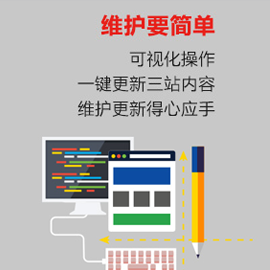bs4庫解析器怎么使用-創(chuàng)新互聯(lián)
創(chuàng)新互聯(lián)www.cdcxhl.cn八線動態(tài)BGP香港云服務(wù)器提供商,新人活動買多久送多久,劃算不套路!

這篇文章將為大家詳細(xì)講解有關(guān)bs4庫解析器怎么使用,文章內(nèi)容質(zhì)量較高,因此小編分享給大家做個參考,希望大家閱讀完這篇文章后對相關(guān)知識有一定的了解。
bs4庫之所以能快速的定位我們想要的元素,是因為它能夠用一種方式將html文件解析了一遍 ,不同的解析器有不同的效果。
bs4解析器的選擇
網(wǎng)絡(luò)爬蟲的最終目的就是過濾選取網(wǎng)絡(luò)信息,最重要的部分可以說是解析器。解析器的優(yōu)劣決定了爬蟲的速度和效率。bs4庫除了支持我們上文用過的‘html.parser’解析器外,還支持很多第三方的解析器,下面我們來對他們進(jìn)行對比分析。
bs4庫官方推薦我們使用的是lxml解析器,原因是它具有更高的效率,所以我們也將采用lxml解析器。
lxml解析器的安裝:
依舊采用pip安裝工具來安裝:
pip install lxml
使用lxml解析器來解釋網(wǎng)頁
我們以愛麗絲文檔 為例子
html_doc = """ <html><head><title>The Dormouse's story</title></head> <body> <p class="title"><b>The Dormouse's story</b></p> <p class="story">Once upon a time there were three little sisters; and their names were <a href="http://example.com/elsie" class="sister" id="link1">Elsie</a>, <a href="http://example.com/lacie" class="sister" id="link2">Lacie</a> and <a href="http://example.com/tillie" class="sister" id="link3">Tillie</a>; and they lived at the bottom of a well.</p> <p class="story">...</p> """
嘗試一下
import bs4
#首先我們先將html文件已lxml的方式做成一鍋湯
soup = bs4.BeautifulSoup(open('Beautiful Soup 爬蟲/demo.html'),'lxml')
#我們把結(jié)果輸出一下,是一個很清晰的樹形結(jié)構(gòu)。
#print(soup.prettify())
'''
OUT:
<html>
<head>
<title>
The Dormouse's story
</title>
</head>
<body>
<p class="title">
<b>
The Dormouse's story
</b>
</p>
<p class="story">
Once upon a time there were three little sisters; and their names were
<a class="sister" href="http://example.com/elsie" id="link1">
Elsie
</a>
,
<a class="sister" href="http://example.com/lacie" id="link2">
Lacie
</a>
and
<a class="sister" href="http://example.com/tillie" id="link3">
Tillie
</a>
;
and they lived at the bottom of a well.
</p>
<p class="story">
...
</p>
</body>
</html>
'''如何具體的使用?
bs4 庫首先將傳入的字符串或文件句柄轉(zhuǎn)換為 Unicode的類型,這樣,我們在抓取中文信息的時候,就不會有很麻煩的編碼問題了。當(dāng)然,有一些生僻的編碼 如:‘big5’,就需要我們手動設(shè)置編碼:
soup = BeautifulSoup(markup, from_encoding="編碼方式")
對象的種類:
bs4 庫將復(fù)雜的html文檔轉(zhuǎn)化為一個復(fù)雜的樹形結(jié)構(gòu),每個節(jié)點都是Python對象 ,所有對象可以分為以下四個類型:Tag , NavigableString , BeautifulSoup , Comment
我們來逐一解釋:
Tag: 和html中的Tag基本沒有區(qū)別,可以簡單上手使用
NavigableString: 被包裹在tag內(nèi)的字符串
BeautifulSoup: 表示一個文檔的全部內(nèi)容,大部分的時候可以吧他看做一個tag對象,支持遍歷文檔樹和搜索文檔樹方法。
Comment:這是一個特殊的NavigableSting對象,在出現(xiàn)在html文檔中時,會以特殊的格式輸出,比如注釋類型。
搜索文檔樹的最簡單的方法就是搜索你想獲取tag的的name:
soup.head # <head><title>The Dormouse's story</title></head> soup.title # <title>The Dormouse's story</title>
如果你還想更深入的獲得更小的tag:例如我們想找到body下的被b標(biāo)簽包裹的部分
soup.body.b # <b>The Dormouse's story</b>
但是這個方法只能找到按順序第一個出現(xiàn)的tag
獲取所有的標(biāo)簽?zāi)兀?/p>
這個時候需要find_all()方法,他返回一個列表類型
tag=soup.find_all('a')
# [<a class="sister" href="http://example.com/elsie" id="link1">Elsie</a>,
# <a class="sister" href="http://example.com/lacie" id="link2">Lacie</a>,
# <a class="sister" href="http://example.com/tillie" id="link3">Tillie</a>]
#假設(shè)我們要找到a標(biāo)簽中的第二個元素:
need = tag[1]tag的.contents屬性可以將tag的子節(jié)點以列表的方式輸出:
head_tag = soup.head head_tag # <head><title>The Dormouse's story</title></head> head_tag.contents [<title>The Dormouse's story</title>] title_tag = head_tag.contents[0] print(title_tag) # <title>The Dormouse's story</title> title_tag.contents # [u'The Dormouse's story']
另外通過tag的 .children生成器,可以對tag的子節(jié)點進(jìn)行循環(huán):
for child in title_tag.children: print(child) # The Dormouse's story
這種方式只能遍歷出子節(jié)點。如何遍歷出子孫節(jié)點呢?
子孫節(jié)點:比如 head.contents 的子節(jié)點是<title>The Dormouse's story</title>,這里 title本身也有子節(jié)點:‘The Dormouse‘s story’ 。這里的‘The Dormouse‘s story’也叫作head的子孫節(jié)點
for child in head_tag.descendants: print(child) # <title>The Dormouse's story</title> # The Dormouse's story
如何找到tag下的所有的文本內(nèi)容呢?
1、如果該tag只有一個子節(jié)點(NavigableString類型):直接使用tag.string就能找到。
2、如果tag有很多個子、孫節(jié)點,并且每個節(jié)點里都string:
我們可以用迭代的方式將其全部找出:
for string in soup.strings: print(repr(string)) # u"The Dormouse's story" # u'\n\n' # u"The Dormouse's story" # u'\n\n' # u'Once upon a time there were three little sisters; and their names were\n' # u'Elsie' # u',\n' # u'Lacie' # u' and\n' # u'Tillie' # u';\nand they lived at the bottom of a well.' # u'\n\n' # u'...' # u'\n'
關(guān)于bs4庫解析器怎么使用就分享到這里了,希望以上內(nèi)容可以對大家有一定的幫助,可以學(xué)到更多知識。如果覺得文章不錯,可以把它分享出去讓更多的人看到。
本文名稱:bs4庫解析器怎么使用-創(chuàng)新互聯(lián)
本文來源:http://www.chinadenli.net/article26/digjjg.html
成都網(wǎng)站建設(shè)公司_創(chuàng)新互聯(lián),為您提供定制開發(fā)、標(biāo)簽優(yōu)化、電子商務(wù)、外貿(mào)網(wǎng)站建設(shè)、全網(wǎng)營銷推廣、軟件開發(fā)
聲明:本網(wǎng)站發(fā)布的內(nèi)容(圖片、視頻和文字)以用戶投稿、用戶轉(zhuǎn)載內(nèi)容為主,如果涉及侵權(quán)請盡快告知,我們將會在第一時間刪除。文章觀點不代表本網(wǎng)站立場,如需處理請聯(lián)系客服。電話:028-86922220;郵箱:631063699@qq.com。內(nèi)容未經(jīng)允許不得轉(zhuǎn)載,或轉(zhuǎn)載時需注明來源: 創(chuàng)新互聯(lián)
猜你還喜歡下面的內(nèi)容
- Android7.0新特性詳解-創(chuàng)新互聯(lián)
- Django中信號signals的簡單使用方法-創(chuàng)新互聯(lián)
- Angular瀏覽器插件Batarang介紹及使用-創(chuàng)新互聯(lián)
- php7.1安裝swoole擴(kuò)展的方法-創(chuàng)新互聯(lián)
- jQuery模仿ToDoList實現(xiàn)簡單的待辦事項列表-創(chuàng)新互聯(lián)
- MIMETYPEMIME-Types類型集合是怎樣的-創(chuàng)新互聯(lián)
- android中怎么全局監(jiān)控click事件-創(chuàng)新互聯(lián)

- 最快最穩(wěn)定的網(wǎng)站排名快速提升的方法 2021-03-25
- SEO優(yōu)化網(wǎng)站排名優(yōu)化有哪些實用的技巧 2022-11-28
- 網(wǎng)站排名優(yōu)化的原理解析 2013-12-26
- 網(wǎng)站點擊率與網(wǎng)站排名的關(guān)系 2014-01-03
- 什么是錨文本,對網(wǎng)站排名有效果嗎? 2021-06-11
- 網(wǎng)站排名提升的方式有哪些? 2023-04-23
- 【SEO優(yōu)化】不斷更新SEO優(yōu)化技巧才能使網(wǎng)站排名更靠前 2022-02-16
- 網(wǎng)站排名不穩(wěn)怎么辦 其實這樣可以網(wǎng)站優(yōu)化 2022-06-30
- 綜合使用各種有效方法來提升Alexa網(wǎng)站排名 2013-11-23
- 成都網(wǎng)站優(yōu)化分享第三方提升網(wǎng)站排名的技巧 2023-04-20
- 濰坊競價托管不絕完善網(wǎng)站優(yōu)化打算,是不變網(wǎng)站排名的重要 2023-01-04
- 建筑業(yè)網(wǎng)站排名優(yōu)化服務(wù)有哪些? 2016-12-25